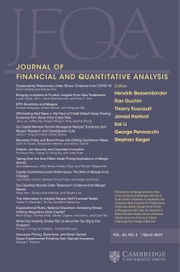Article contents
A Social Norm Perspective on Distorted Information in China
Published online by Cambridge University Press: 01 July 2025
Abstract
Can social norms give rise to distorted information in China? We observe that China’s leading social norm related to alcohol consumption and social drinking enhances earnings management. An analysis of toxic alcohol scandals supports a causal interpretation. Further evidence suggests that the influence of alcohol may come from the negative externality that it creates, which is propagated by corporate leaders and cannot be attenuated by market-oriented institutions. Our results reveal a social norm externality that may have important normative implications.
Information
- Type
- Research Article
- Information
- Creative Commons
- This is an Open Access article, distributed under the terms of the Creative Commons Attribution-NonCommercial-NoDerivatives licence (http://creativecommons.org/licenses/by-nc-nd/4.0), which permits non-commercial re-use, distribution, and reproduction in any medium, provided that no alterations are made and the original article is properly cited. The written permission of Cambridge University Press must be obtained prior to any commercial use and/or adaptation of the article.
- Copyright
- © The Author(s), 2025. Published by Cambridge University Press on behalf of the Michael G. Foster School of Business, University of Washington
Footnotes
We thank Mara Faccio (the editor), an anonymous referee, Lauren Cohen, Robert Engle, Huasheng Gao, Mariassunta Giannetti, Will Gornall, John Griffin, Zhiguo He, Pierre Hillion, Wei Jiang, Marcin Kacperczyk, Andrew Karolyi, Chen Lin, Christian T. Lundblad, Robert S. Marquez, William L. Megginson, Joseph Pacelli, Zheng (Michael) Song, Matthew Spiegel, Laura Starks, James Vickery, Michael Weber, John Wei, Wei Xiong, Frank Yu, Jianfeng Yu, Kathy Yuan, Xiaodong Zhu for their helpful comments.
References
- 1
- Cited by

